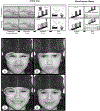Children's Facial Muscular Movements and Risk for Early Psychopathology: Assessing Clinical Utility
- PMID: 32138936
- PMCID: PMC7476425
- DOI: 10.1016/j.beth.2019.08.004
Children's Facial Muscular Movements and Risk for Early Psychopathology: Assessing Clinical Utility
Abstract
Standardized developmentally based assessment systems have transformed the capacity to identify transdiagnostic behavioral markers of mental disorder risk in early childhood, notably, clinically significant irritability and externalizing behaviors. However, behavior-based instruments that both differentiate risk for persistent psychopathology from normative misbehavior, and are feasible for community clinicians to implement, are in nascent phases of development. Young children's facial expressions during frustration challenges may form the basis for novel assessments tools that are flexible, quick, and easy to implement as markers of psychopathology to complement validated questionnaires. However, the accuracy of facial expressions to correctly classify young children falling above and below clinical cut-offs is unknown. Our goal was to test how facial expressions during frustration, defined by different facial muscular movements, related to individual differences in irritability and externalizing behaviors and discriminated children with clinically significant levels from peers. Participants were 79 children (ages 3-7) who completed a short, moderately frustrating computer task while facial expressions were recorded. Only negative facial expressions that included eye constriction related to irritability and externalizing behaviors and were clinically discriminating. Moreover, these expressions significantly discriminated children with and without clinically significant irritability and externalizing symptoms with high Area Under the Curve (AUC) values (> .75) indicating good clinical utility. In contrast, expressions without eye constriction showed no clinical utility. The presence of negative expressions with eye constriction in response to a short frustration prompt may serve as an indicator of early psychopathology, raising the potential for novel assessment tools that may enhance precision of early identification.
Keywords: ROC curve; child; facial expression; psychopathology; risk assessment.
Copyright © 2019. Published by Elsevier Ltd.
Conflict of interest statement
Conflict of Interest Statement
The authors declare that there are no conflicts of interest.
Figures


References
-
- Achenbach TM, & Rescorla LA (2000). Manual for the ASEBA preschool forms and profiles. (Vol. 30): Burlington, VT: University of Vermont, Research center for children, youth; …..
-
- American Psychiatric Association (2013). Diagnostic and statistical manual of mental disorders (DSM-5). Washington, DC: Author.
Publication types
MeSH terms
Grants and funding
LinkOut - more resources
Full Text Sources
Medical

